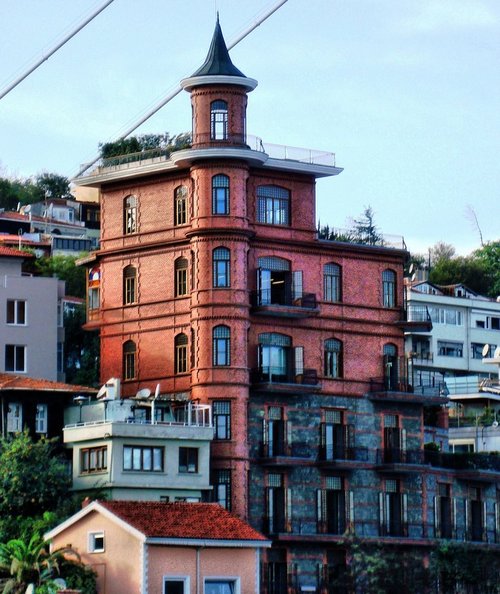
Kaya Genç on Visiting the Headquarters of Borusan Holding
One day in Istanbul last Summer, I took a bus from Taksim to Rumelihisarı and, after half an hour drive, got off in front of a nine-storey building that overlooks the shiny waters of the Bosphorus. A red-brick mansion built in the 1910s, locals have come to know the place as Perili Köşk, which, in English means, “The Haunted Mansion.” Perili Köşk is the headquarters of Borusan Holding, a massive Turkish firm that sells steel products, including general purpose pipes. The building itself is located close to the steel legs of the Fatih Sultan Mehmet bridge and, once inside, you get a nice view of the interiors of numerous vehicles—some of which Borusan sold to customers as Turkey’s distributor for BMW, Mini and Land Rover cars—stuck in between Asia and Europe.
Dressed in casual attire I looked at the brick-colored façade of the Haunted Mansion which has the shape of a creatively re-imagined stack of Tetris blocks, and walked toward the doors, which were wide open, despite it being a Sunday morning. A security guard greeted me at the entrance. I was not carrying anything business-related with me—just a tote bag with a small bottle of cold water, a Moleskine reporter notebook, and Nikil Saval’s book Cubed: A Secret History of the Workplace. I feared the book would get wet because of the water bottle, so I took the book outside. The security guard looked at its cover with interest and did not ask for my ID or security pass. Then he asked whether I wanted a normal ticket or a reduced pass.
Perili Köşk is the Dr. Jekyll and Mr. Hyde of Istanbul’s office buildings: during the week, it serves as Borusan Holding’s headquarters—a site of commerce and capitalism—and on the weekends, it becomes the Borusan Contemporary, an art museum with the entry fee of 10 liras.
*
Walking among desks on the fourth floor I saw pictures of office workers’ relatives. This proved to be an unsettling experience. I wouldn’t be so keen on my pictures being spied upon by total strangers, after all. The open plan design of the office made it easier to see things. I saw favorite stationary objects and colorful post-its of workers. I saw folders carefully placed on tables. I saw notebooks whose pages I assumed were blank. A blanket was placed in a corner, as if waiting for the weather to become colder. In one of the upper floors, where there are old-fashioned offices of high ranking executives, I saw large ashtrays on tables which looked forward to the moment when their owners would smoke cigars and cigarettes whilst...
You have reached your article limit
Sign up for a digital subscription and continue reading all new issues, plus our entire archives, for just $1.50/month.
Already a subscriber? Sign in




